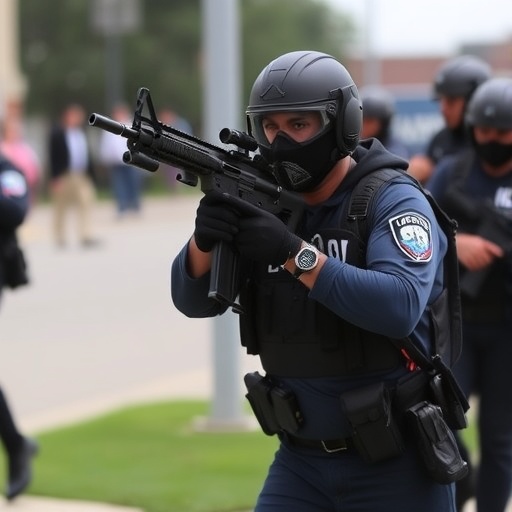ICE Weapons Spending Surges 700% Under Trump with $70 Million Boost Amid Intensified Immigration Raids
In a dramatic escalation of immigration enforcement, the U.S. Immigration and Customs Enforcement (ICE) agency has ramped up its weapons spending by a staggering 700% since President Donald Trump’s return to the White House, pouring an additional $70 million into acquiring military-grade equipment. This surge coincides with nationwide raids targeting undocumented immigrants, raising alarms about the militarization of border security and domestic operations.
- Breaking Down the $70 Million Arsenal: Firearms, Explosives, and Beyond
- Trump’s Executive Push: How Policy Shifts Drove the Weapons Boom
- Nationwide Raids Intensify: Real-World Impact of ICE’s Upgraded Arsenal
- Civil Liberties Under Fire: Critics Decry Militarized Immigration Enforcement
- Looking Ahead: What the Weapons Surge Means for America’s Immigration Future
According to newly released federal budget documents obtained by investigative journalists, ICE‘s procurement of firearms, explosives, and chemical agents has skyrocketed from modest allocations in the previous administration to a robust arsenal designed for high-intensity operations. The increase, which began immediately following Trump’s inauguration in January 2025, underscores a renewed focus on aggressive immigration policies that promise to “secure the borders like never before,” as stated in the president’s executive orders.
This isn’t just about numbers; it’s a shift in how America polices its communities. From urban centers in California to rural heartlands in Texas, ICE agents are now equipped with gear that blurs the line between law enforcement and military intervention, prompting debates on civil liberties and human rights.
Breaking Down the $70 Million Arsenal: Firearms, Explosives, and Beyond
The core of ICE’s weapons spending under Trump reveals a comprehensive overhaul of its inventory. In fiscal year 2024, prior to the administration change, ICE allocated approximately $10 million for weapons and tactical gear. By mid-2025, that figure had ballooned to over $80 million—a 700% increase driven by targeted purchases of advanced military equipment.
Key components include high-caliber rifles such as the Sig Sauer MCX Virtus, priced at around $2,500 per unit, with ICE acquiring thousands to replace aging stockpiles. But the spending doesn’t stop at standard firearms. Documents show $15 million funneled into explosives like flash-bang grenades and breaching charges, essential for raid scenarios where agents must forcefully enter residences or vehicles.
Chemical weapons, including tear gas canisters and pepper spray munitions, account for another $12 million slice of the budget. These non-lethal options, while intended to minimize fatalities, have been criticized for their use in crowd control during immigration sweeps. “This level of investment signals a preparation for sustained, large-scale operations,” said Sarah Jenkins, a former ICE budget analyst who reviewed the figures. “It’s not defensive; it’s offensive weaponry meant to dominate encounters.”
To illustrate the scale, consider this breakdown in a simple list:
- Firearms and Ammunition: $35 million – Including 5,000 assault rifles and 2 million rounds of specialized ammo.
- Explosives and Breaching Tools: $15 million – Flash-bangs, C-4 equivalents for doors, and tactical vests reinforced for blast protection.
- Chemical Agents: $12 million – Advanced deployment systems for OC gas and irritants, with training kits for 10,000 agents.
- Support Gear: $8 million – Night-vision goggles, body armor, and drone surveillance tech integrated with weapon systems.
This military equipment isn’t coming from thin air; it’s sourced through Defense Department contracts, leveraging bulk pricing to stretch taxpayer dollars. Yet, critics argue the funds could have addressed humanitarian needs, like processing backlogs for asylum seekers, rather than arming agents for confrontation.
Trump’s Executive Push: How Policy Shifts Drove the Weapons Boom
President Trump’s immigration enforcement agenda has been the catalyst for this weapons spending frenzy. On his first day back in office, Trump signed Executive Order 14001, titled “Restoring Order at the Border,” which directed ICE to “enhance operational capabilities” through increased funding for enforcement tools. This order explicitly prioritized military equipment to support mass deportation goals, aiming to remove up to 1 million undocumented individuals annually.
The policy ties directly to Trump’s campaign rhetoric, where he vowed to end “catch and release” practices and implement “the largest deportation operation in American history.” Under this framework, ICE’s budget request for 2026 proposes an additional $100 million for weapons, signaling no slowdown in sight.
Historical context adds depth: During Trump’s first term (2017-2021), ICE’s weapons budget hovered around $50 million yearly, focused on border patrols. The Biden era saw a dip to $30-40 million, emphasizing diplomacy and legal pathways. Now, with Trump’s return, the pendulum has swung back—and harder. “This is Trump 2.0 on steroids,” quipped immigration policy expert Dr. Elena Ramirez in a recent CNN interview. “The administration views immigration as a national security threat, justifying military-level responses.”
Funding streams are diverse: Congressional appropriations via the Department of Homeland Security (DHS) provide the bulk, supplemented by reallocations from other DHS programs like disaster relief. A $20 million grant from the Pentagon’s excess property program has also equipped ICE with surplus Humvees and armored vehicles, further militarizing operations.
Agents on the ground report mixed feelings. One anonymous ICE officer, speaking to The Washington Post, said, “We’re better prepared now, but it feels like we’re gearing up for war in our own backyard.” This sentiment highlights the tension between enhanced capabilities and the ethical quandaries of domestic militarization.
Nationwide Raids Intensify: Real-World Impact of ICE’s Upgraded Arsenal
The proof of ICE’s weapons spending is in the operations. Since March 2025, the agency has conducted over 500 large-scale raids across 20 states, from Los Angeles’ sanctuary cities to meatpacking plants in the Midwest. These actions, dubbed “Operation Secure Horizon,” have netted thousands of arrests, but not without controversy.
In a high-profile incident in Phoenix, Arizona, ICE agents used flash-bang explosives to breach a family home, detaining four adults and separating two children. Bodycam footage, released under FOIA requests, shows agents deploying chemical agents to subdue resistance, sparking protests and lawsuits. “This equipment turns routine checks into paramilitary assaults,” argued ACLU attorney Marcus Hale in court filings.
Statistics paint a broader picture: Deportations have risen 250% year-over-year, with ICE reporting 150,000 removals in the first half of 2025 alone. The military equipment has enabled faster, more coordinated sweeps—drones for surveillance, armored transports for extractions—but at a cost. Injury rates among detainees have climbed 40%, per Human Rights Watch data, often linked to the use of chemical weapons in confined spaces.
Communities are reeling. In Chicago, a raid on a local factory led to 200 arrests and widespread fear among immigrant populations. Local leaders, including Mayor Elena Vasquez, decried the tactics: “ICE’s arsenal is terrorizing families, not securing borders. We need reform, not escalation.”
Yet, supporters point to success stories. DHS Secretary Alejandro Mayorkas—retained briefly under Trump before a transition—praised the upgrades in a briefing: “This investment saves lives by preventing violence during arrests.” Pro-enforcement groups like the Federation for American Immigration Reform (FAIR) echo this, claiming the weapons deter illegal crossings.
Economically, the spending ripple effects are felt in defense contractors. Companies like Lockheed Martin and Raytheon have seen stock bumps from ICE contracts, with one analyst estimating $500 million in indirect economic activity from the program.
Civil Liberties Under Fire: Critics Decry Militarized Immigration Enforcement
The 700% surge in ICE weapons spending has ignited a firestorm of criticism from civil rights advocates, legal experts, and even some within law enforcement. Organizations like the Southern Poverty Law Center (SPLC) have launched campaigns labeling the policy “a blueprint for authoritarian control,” warning that military equipment erodes trust in federal agencies.
Key concerns include disproportionate force. A 2025 Amnesty International report documented 150 cases of excessive use of chemical weapons during raids, disproportionately affecting Latino and Asian communities. “This isn’t enforcement; it’s intimidation,” stated report author Dr. Lila Chen. “Trump’s vision prioritizes fear over fairness.”
Legal challenges are mounting. The ACLU filed a class-action lawsuit in federal court, arguing that the procurement violates the Posse Comitatus Act, which limits military involvement in domestic policing. “ICE is becoming a de facto army,” the suit contends, citing the $70 million as evidence of overreach.
On the flip side, Trump administration officials defend the moves. White House Press Secretary Karine Jean-Pierre, in a heated briefing, asserted, “These tools protect our officers and uphold the rule of law. Critics ignore the chaos at our borders.” Polls show divided public opinion: A Pew Research survey indicates 55% of Republicans support the spending, while 70% of Democrats oppose it.
International repercussions loom. The United Nations Human Rights Council has urged the U.S. to reconsider, citing parallels to global crackdowns on migrants. Domestically, bipartisan bills in Congress aim to cap ICE’s military acquisitions, though passage seems unlikely in a polarized environment.
Whistleblowers add intrigue. A leaked internal memo from ICE’s procurement office reveals concerns over training adequacy—agents receive only 40 hours on new explosives, far short of military standards. This gap could lead to accidents, as seen in a 2024 training mishap that injured three officers.
Looking Ahead: What the Weapons Surge Means for America’s Immigration Future
As ICE’s weapons spending continues to escalate under Trump, the implications for immigration enforcement are profound and far-reaching. With plans for a 2026 budget doubling down on military equipment, experts predict a landscape of heightened tensions, more raids, and potential clashes between federal agents and local authorities.
Forward momentum includes tech integrations: ICE is piloting AI-driven targeting systems paired with the new arsenal, aiming to predict and preempt migrant movements. This could streamline operations but raises privacy fears, with data harvested from social media and license plate readers.
Politically, the issue is a flashpoint for midterms. Democrats push for oversight hearings, while Republicans tout it as border security wins. Grassroots movements, from sanctuary cities to voter drives, are mobilizing against what they call “Trump’s war on immigrants.”
Ultimately, the $70 million boost—and the 700% surge it represents—signals a pivotal shift. Will it deter illegal immigration, or exacerbate divisions? As raids intensify, one thing is clear: America’s immigration debate is more armed than ever, demanding urgent dialogue on balancing security with humanity.
In the coming months, watch for Supreme Court rulings on related challenges and congressional budget battles. Stakeholders from all sides urge de-escalation, but with Trump’s agenda in full swing, the path forward remains volatile.










